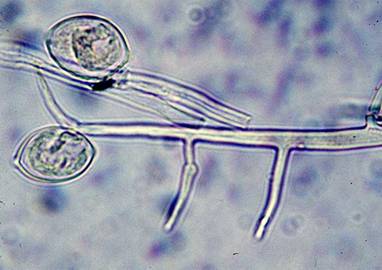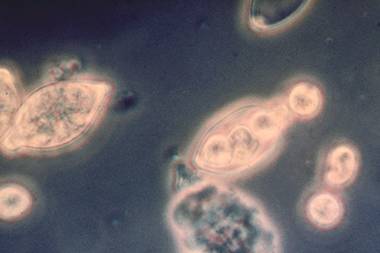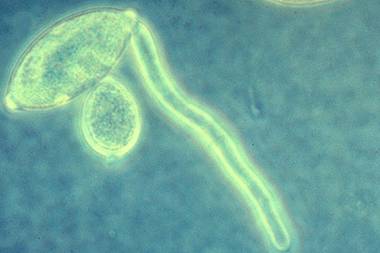

|
Life History & Reproduction |

|
Because P. infestans is a host-specific parasite, it needs plant tissue to grow in. Usually, as was the case in Ireland, P. infestans reproduces asexually. Its life cycle usually begins as the sporangia are carried by the wind, land on plant tissue, and |
|
release their zoospores (Judelson 1997). This will happen when the conditions are wet and cool and is called indirect germination. These spores are biflagellated—having both a tinsel and whiplash flagellum which is characteristic of oomycota and will swim until they encyst in the host. When conditions are warmer, P. infestans will infect the plant by direct germination—that is a germ tube will form from the sporangium and will penetrate the host tissue allowing it to gain nutrients from its host (Schumann and D’Arcy 2000). |
|
Sexual reproduction, can and does occur when both mating types are present. The antheridium and oogonium (the only haploid parts in the life cycle of P. infestans) nuclei will fuse together (karyogamy) when the antheridium enters the oogonium. They will form a diploid oospore, which will develop into a sporangium and the cycle will continue as is would asexually (Schumann and D’Arcy 2000).
|




|
Infected plants show signs of small brown or black lesions on the leaves or stems, but soon spread and kill the plant. The growth of sporangia on the surface of the leaves or stems makes is white, which is another warning sign of infection. Tubers can also become infected when the sporangium are washed into the soil. The tubers will show signs by copper brown, reddish, or purplish color in the cracks, eyes, or lenticels. Soft rot (not to be confused with soft rock) bacteria will then invade causing the tuber to become smelly and rotten. Similar signs exist for the tomato plants (Schumann and D’Arcy 2000). |

|
Photo Credits 1. Courtesy T.J. Volk. Reproduced with permission from T.J. Volk. 2001. Phytophthora infestans, cause of late blight of potato and the Irish potato famine. 2. Courtesy G.L. Schumann and C.J. D'Arcy. Reproduced with permission from Schumann, G. L. and C. J. D’Arcy. 2000. Late blight of potato and tomato. The Plant Health Instructor. DOI: 10.1094/PHI-I-2000-0724-01. 3. Courtesy of Plant Pathology Section, West Virginia University. Reproduced with permission from Schumann, G. L. and C. J. D’Arcy. 2000. Late blight of potato and tomato. The Plant Health Instructor. DOI: 10.1094/PHI-I-2000-0724-01. 4. Courtesy H. D. Thurston. Reproduced with permission from Schumann, G. L. and C. J. D’Arcy. 2000. Late blight of potato and tomato. The Plant Health Instructor. DOI: 10.1094/PHI-I-2000-0724-01. 5. Courtesy H. D. Thurston. Reproduced with permission from Schumann, G. L. and C. J. D’Arcy. 2000. Late blight of potato and tomato. The Plant Health Instructor. DOI: 10.1094/PHI-I-2000-0724-01. |
|
Phytophthora infestans sporangium (1). |
|
(2). |
|
Oospore with antheridium (3). |
|
Germinating sporangium (4). |
|
Zoospores emerging from a sporangium (5). |